Related Research Articles

In baseball statistics, a hit, also called a base hit, is credited to a batter when the batter safely reaches or passes first base after hitting the ball into fair territory, without the benefit of an error or a fielder's choice.
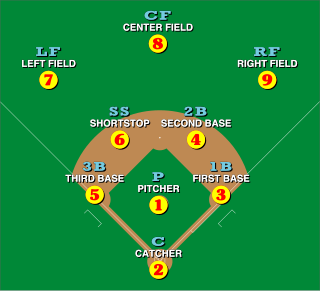
In the sport of baseball, each of the nine players on a team is assigned a particular fielding position when it is their turn to play defense. Each position conventionally has an associated number, for use in scorekeeping by the official scorer: 1 (pitcher), 2 (catcher), 3, 4, 5, 6 (shortstop), 7 8, and 9. Collectively, these positions are usually grouped into three groups: the outfield, the infield, and the battery. Traditionally, players within each group will often be more able to exchange positions easily ; however, the pitcher and catcher are highly specialized positions and rarely will play at other positions.

Softball is a game similar to baseball played with a larger ball on a field that has base lengths of 60 feet, a pitcher's mound that ranges from 35 to 43 feet away from home plate, and a home run fence that is 220–300 feet away from home plate, depending on the type of softball being played. Softball is played competitively at club levels, the college level, and the professional level.

Catcher is a position for a baseball or softball player. When a batter takes their turn to hit, the catcher crouches behind home plate, in front of the (home) umpire, and receives the ball from the pitcher. In addition to this primary duty, the catcher is also called upon to master many other skills in order to field the position well. The role of the catcher is similar to that of the wicket-keeper in cricket, but in cricket, wicketkeepers are increasingly known for their batting abilities.

The infield fly rule is a rule of baseball and softball that treats certain fly balls as though caught, before the ball is caught, even if the infielder fails to catch it or drops it on purpose. The umpire's declaration of an infield fly means that the batter is out regardless of whether the ball is caught. The rule exists solely to prevent the defense from executing a double play or triple play by deliberately failing to catch a ball that an infielder could catch with ordinary effort.

The rules of baseball differ slightly from league to league, but in general share the same basic game play.

A baseball field, also called a ball field or baseball diamond, is the field upon which the game of baseball is played. The term can also be used as a metonym for a baseball park. The term sandlot is sometimes used, although this usually refers to less organized venues for activities like sandlot ball.
In baseball, interference occurs in situations in which a person illegally changes the course of play from what is expected. Interference might be committed by players on the offense, players not currently in the game, catchers, umpires, or spectators. Each type of interference is covered differently by the rules.
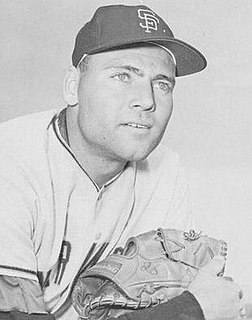
In baseball, a pitcher can commit a number of illegal motions or actions that constitute a balk. Most of these violations involve pitchers pretending to pitch when they have no intention of doing so. In games played under the Official Baseball Rules that govern professional play in the United States and Canada, a balk results in a dead ball or delayed dead ball. In certain other circumstances, a balk may be wholly or partially disregarded. Under other rule sets, notably in the United States under the National Federation of State High School Associations, a balk results in an immediate dead ball. In the event a balk is enforced, the pitch is generally nullified, each runner is awarded one base, and the batter (generally) remains at bat, and with the previous count. The balk rule in Major League Baseball was introduced in 1898.
Stoop ball is a game that is played by throwing a ball against a stoop on the pavement in front of a building. Historically, it has been popular in Brooklyn and other inner cities. In Boston, the game is known as "Up-Against." In Chicago, the game is known as "Pinners." In Chicago's Bridgeport area the game is called "Three Outs". The game is also known as "Off the Point". It first became popular after World War II.
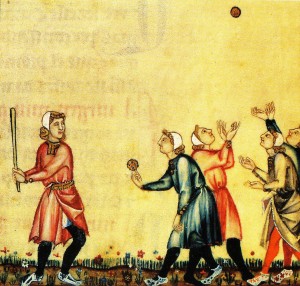
Bat-and-ball games are field games played by two opposing teams, in which the action starts when the defending team throws a ball at a dedicated player of the attacking team, who tries to hit it with a bat and run between various safe areas in the field to score runs (points), while the defending team can use the ball in various ways against the attacking team's players to force them off the field when they are not in safe zones, and thus prevent them from further scoring. The best known modern bat-and-ball games are cricket and baseball, with common roots in the 18th-century games played in England.
This is an alphabetical list of selected unofficial and specialized terms, phrases, and other jargon used in baseball, along with their definitions, including illustrative examples for many entries.
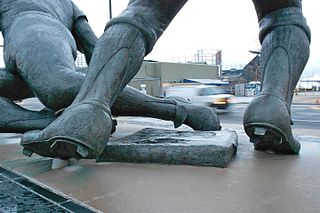
In baseball, a neighborhood play is a force play in which a fielder receiving the ball in attempting to force out a runner at second base, catches and quickly throws the ball to first base in a double play attempt without actually touching second base, or by touching second base well before catching the ball. By every rules code, such a play is not an out, because to record a force out, the fielder with the ball must actually touch a force base before the forced runner arrives.
Wireball is a street game related to baseball, usually formed as a pick-up game, in urban areas of the United States. The equipment consists of a pimple or pensie pinkie ball and a convenient place in a street or driveway where an electric power line or group of power lines bisect horizontally. The rules come from baseball and are modified to fit the situation. It can be played with one or more persons per team.
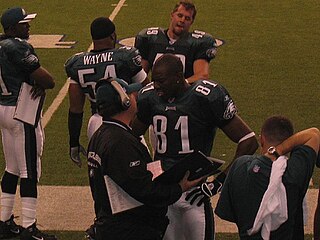
In sports, out of bounds refers to being outside the playing boundaries of the field. Due to the chaotic nature of play, it is normal in many sports for players and/or the ball to go out of bounds frequently during a game. The legality of going out of bounds, and the ease of prevention, vary by sport. In some cases, players may intentionally go or send the ball out of bounds when it is to their advantage.

Baseball is a bat-and-ball sport that has many recreational variants, and is very related to the Olympic discipline of softball, with the two sports being administered internationally alongside Baseball5 by the World Baseball Softball Confederation.
References
- ↑ "Sun Times Chicagopedia-Pinners". Archived from the original on 2008-11-23.
- 1 2 3 4 5 6 Gale, Neil (12 January 2017). "Pinners is a Chicagoland Baseball Game Played by Children Living in Congested Neighborhoods". The Digital Research Library of Illinois History Journal.
- ↑ "Chicago Pinners". 3 July 2013. Archived from the original on 2021-12-15.
- ↑ "Chicago Tribune-Play, from back in the day".
- ↑ "Anyone ever play pinners | Chicago - Yelp". Yelp.
- ↑ "Chicago School Yard Baseball FastPitch 11/18/07". 19 November 2007. Archived from the original on 2021-12-15.
- ↑ Cayton, Andrew R. L.; Sisson, Richard; Zacher, Chris (2006). The American Midwest: An Interpretive Encyclopedia. Indiana University Press. p. 880. ISBN 0253003490.
- ↑ "Chicago Magazine-24 Phrases You'll Only Hear in Chicago".